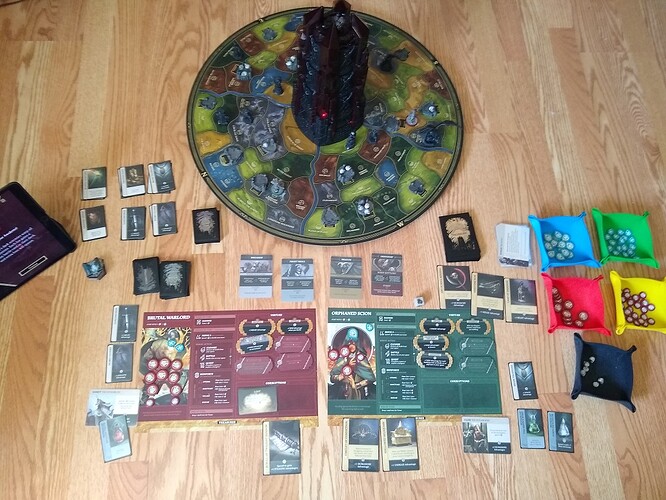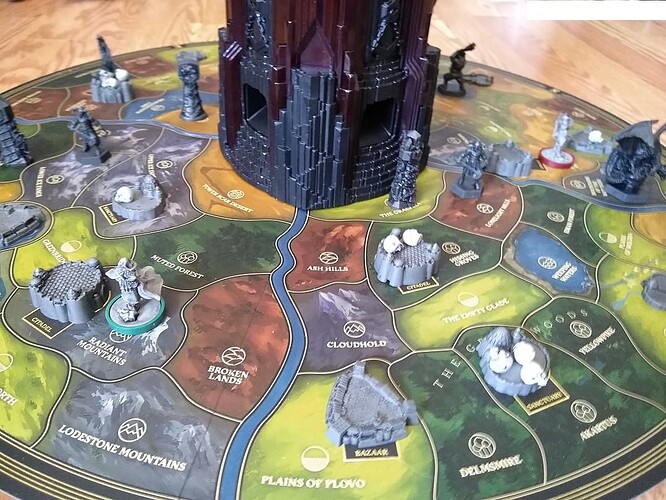Speaking of solitaire boardgaming, look what showed up last weekend…
Yep, ye olde Return to Dark Tower. I’ve played 4 games so far with different Big Bads and Main Quests solo, as well as 1 game with two friends.
Let me say this right off the bat: this is the kind of game that I can imagine Very Serious Boardgamers hating with the white hot passion of a thousand suns. I mean, the Tower itself – that thing is goofy as hell! Plus: it requires an APP. Holy shit! This poor game has already sinned mightily right from the get-go!
But that goofy-ass tower is WHY dummies like me backed this. In junior high, my friend Brian (who btw, grew up to write award-winning biographies of George Lucas, Jim Henson, Dr. Seuss, and Washington Irving) had the original Dark Tower, and I can well remember playing it with him and his brother for HOURS. And the electronic gizmos in the tower were absolutely fascinating. We’d have played 16 hours a day if none of us had really conscientious parents. Dang them.
The old skool Dark Tower gameplay probably doesn’t hold up too well these days, though. So it’s cool that Rob Daviau and Isaac Childres took a stab at some updated rules for this. And, silly tower and app and all…so far I’m feeling pretty favorable to this whole monument to silly electronics excess.
The gameplay is fairly straightforward and easy to grok. You put out the board and put the tower on it. You place four buildings in each of four regions on the board, 16 total. Then you pick a character or characters to play – this game REALLY lends itself to playing multiple characters; it’s fairly easy to do so, and I recommend it especially for solo play. You set up your characters with both Spirit tokens (which are like a universal game currency) and Warriors (which are your fighting strength currency). Finally, you put out your “virtues”; these are special abilities you’ll want to unlock for your characters during the game. Each character is basically in charge of one region of the gameboard – North, East, South, and West. The characters and regions are asymmetrical, and that comes into play during the game.
Then you switch on the Tower and open the App. They communicate to each other via bluetooth, and the Tower (which doesn’t just have computer circuits inside, but also rotating drums and a speaker and seriously it is absolutely both amazingly silly and silly amazing in equal parts). The app asks you to pick your Main Quest (which is basically, “Pick what campaign thingy you want to play”), and then your big bad, and then your foes. It usually then has you put skulls onto buildings around the board and place some of the lower level foes out in various spaces.
The game turns consist of moving around and doing things like fighting monsters on the board, clearing skull tokens off buildings (4 skulls on a building and it is destroyed for the game; if the building is in the home realm of a player, that player picks up a corruption card, too, which have negative effects and can lead to defeat if any player has to take a 3rd corruption). They also reinforce and try to grab gear or potions or treasures. Finally, they can do quests on the board; in the base game, you have companion quests (to get something good) and adversary quests (to stop something bad from happening.)
You get 6 game “months” to build up your characters and get ready for the Big Bad. Each month consists of a variable number of turns (that’s fun) that are randomized by the app) and you use that time to also finish the main quest, which brings the Big Bad out of the tower. Beat him and you win.
I will also guess that a lot of players are going to hate the combat system. This is Daviau and Childres, so you can forget dice-rolling. Instead when you battle a foe, you tell the app what foe it is, and the app has you select a couple of facedown cards in the app. It then reveals a card that has some negative outcome. As a player, you then can mitigate (and even sometimes reverse) the negative effects by using “advantages”. You go through however many cards the foe has and pay the required damages (often in warriors, but also in spirit, items or potions sometimes, putting skulls on buildings, etc; each foe has a list of the special damage they can do.) If you can’t pay, you take as much of the loss as you can, and then get a corruption card – which, 3 of them ends the game. As long as you survive those cards, you win and the foe is defeated.
I also think folks are going to be a little put off by the setup. If I’m remembering the original game board, the buildings on the map were raised, but built into the board itself (kind of like the game Life does). Here you have to put out little minis for the buildings, and it can take a little time to set up (see below for “Hey presto, this is so much faster!”, my modification that makes it much easier/faster.) At first I thought it was like the mini-cruff of Destinies, but as you play, you start looking for the building shapes when you get instructions to put 2 skulls on every citadel on the board, etc.
And yes, there is an app. It handles a lot of encounter stuff. And random events at the end of a turn. And whenever there’s an app game, question one becomes: am I playing the app, or am I playing a boardgame?
Here, I think that the designers have thought a TON about this issue. (In fact, there’s a really good video on Youtube with Daviau talking about this exact thing.) And here I think the game gets it right. Whereas with something like Destinies and I’m wondering why there’s even a board and cards, with Dark Tower almost everything plays out on the board. Other than fighting a foe (which to be honest doesn’t happen as often as you’d think it does), pretty much everything else during a turn happens on the board and with the tower itself. So good on them, there.
And so the Tower. Look, I can imagine someone who doesn’t have that early to mid 1980s fascination in their memory banks utterly baffled as to why my friends and I just had such an amazing time with this thing. But damn is it fun, he said with those 1980s tinted glasses on. After every player finishes a turn, he or she puts a skull into the top of the tower (if there ever aren’t enough skulls – and you only get 24, and those same skulls are going on buildings throughout the game – you lose). Then…the tower may just hold the skull. Or something else happens. What always happens is that the Tower tells the app a turn has ended and some random event occurs. Sometimes, the tower rotates. Sometimes, you take a seal off the tower, to reveal either an open portal, or a light-up glyph that causes a penalty for the players. Sometimes one or more skulls come tumbling out of the tower and have to be placed on buildings.
And so yeah, that description is pretty dry for the fun of dropping that skull into the tower and everyone around the table cringes to see what’s going to happen. But that’s the fun of this thing! Also, when you encounter monsters on the board, the tower plays sound effects for them. It lights up. It signals where to remove seals. It makes scary rotating sounds. It dumps out skulls. And all that stuff is probably nonsense, and you could probably design the same gameplay without the tower…but why would you? The tower is awesome!
There’s a lot more to the game than I’ve described. Monsters, heroes, and terrain all have different effects and such. Monsters get more dangerous as the game goes along. Movement and positioning get more and more important.
It’s a coop game/solo game particularly. There are rules for competitive play, but they seem mostly tacked on. Solo is brilliant fun, controlling multiple characters and such. Coop with other players is actually quite good as well. The game largely avoids most of the Pandemic Problem by making the turns fairly short and punchy and by not even trying to restrict table talk among players.
Finally, there are two accessories that I think are must-haves that you’ll need to buy on your own.
First, you’re really going to want about an 18 to 24" lazy susan – just a flat turntable. The difference in game setup is noticeable when you set the whole board on top of the flat lazy susan. Just be careful how fast you turn it. :)
Second, you’re really going to want a decent set of NiMH AA batteries and a charger. The tower is an absolute battery hog.

